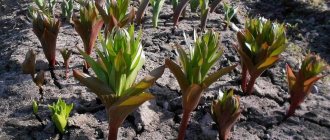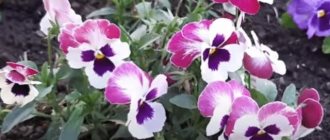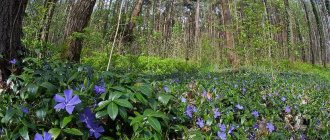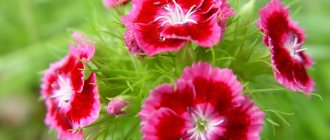In Latin, fritillaria is designated as “hazel grouse”; in common people it is called the “royal crown”. Regardless of the name and variety, fritillaria can be called one of the brightest and most fragrant representatives of the flower world.
A tall and stately plant will be a wonderful addition to the design of a flower bed or garden. The fritillaria flower will not leave any gardener indifferent, and growing the “royal crown” will not be difficult, since hazel grouse is an unpretentious flower and gets along well with its neighbors in the garden.
Fritillaria planting
Proper organization of autumn planting and care of the fritillaria flower, as well as timely control over the plantings, will reward you in the spring with fragrant, lush flowering and a colorful picture of bright hazel grouse buds.
Fritillaria is in demand among most gardeners for its variety of inflorescence color palette and relative unpretentiousness.
Fritillaria is a colorful member of the lily family and has about a hundred varieties of its species. Therefore, choosing the appropriate variety of hazel grouse specifically for your site will not be difficult.
Fritillaria prefers fertile soil, with an average pH level, not clogged, loose and aerated. The planting area should be well lit, but with variable solar activity. In too shaded places, fritillaria will stretch upward, depriving the buds of nutrients, and this will affect the size and color of the inflorescences.
If your area for planting hazel grouse does not meet the above requirements, do not be upset. Poor soil can be easily corrected; to do this, you need to prepare the site in advance. Having dug up the soil at least as deep as a spade, add organic fertilizer 5 buckets for every 5 square meters. m. of land.
Planting of fritillaria begins at the end of August, beginning of September, but not later, since the bulb must take root and have time to gain strength for the upcoming release of the peduncle.
Fritillaria is a large, weighty plant; with a thick, fleshy, tall peduncle, so the planting depth should be at least 25 cm. If the soil of your site is “clogged” or heavy, shallow planting of the bulb up to 25 cm will facilitate germination. But, the optimal solution would be to “lighten” such soil; to do this, add sand (a bucket per 1 sq.m.) and peat (1.5 buckets per sq.m.) into the soil and dig it up.
To correctly calculate the depth of embedding of a fritillaria bulb, you need to multiply the diameter of the bulb by three.
Before planting, fritillaria bulbs are inspected, damaged and suspicious areas are cut off, soaked for several minutes in a solution of potassium permanganate, dried by sprinkling the sections with activated carbon or ash, and then planted.
Holes for planting fritillaria must be formed so that the flowers do not interfere with each other; maintaining a distance of 30 cm between plants will be sufficient. The depth of the hole varies from 25 cm on heavy soils and 35 cm on light soils. A centimeter layer of sand is placed at the bottom of the hole, which will serve as drainage, the soil is abundantly moistened, then the bulb is laid and sprinkled with fertilized soil.
The future flowering and reproduction of the plant will depend on the depth of planting of the fritillaria bulb. The larger the bulb, the deeper the planting. Fritillaria requires a balanced level of soil acidity; the flower will not grow on acidic soils; the same applies to swampy conditions; hazel grouse cannot tolerate stagnant water.
Before planting, think about dispersing the flowers throughout the area; fritillaria blooms all spring and then dies, so it would be better to plant hazel grouse bulbs nearby with other flowers so that the flowerbed does not seem empty.
How does a plant reproduce?
The imperial hazel grouse can reproduce using several methods. Each method has its own characteristics that are important to consider.
Seed propagation method
Propagation of hazel grouse by seeds is very rarely used. Since in order to get a flowering bush, you need to wait at least 5-7 years. In order to propagate a crop by seed, it is necessary to perform the following algorithm of actions:
- Soak the collected seeds in warm water for several hours;
- for planting, boxes up to 15 cm deep are used;
- fill the box with light substrate for seedlings. Plant the seeds and place the box in a cool place, such as a basement;
- at the end of April, put the boxes outside and water the greenery that appears. In August, after the greens have dried, you need to select small bulbs and transplant them into an open area;
- prepare the area. To do this, the soil is carefully dug up and fertilized with humus. For 1 m2 use 10 kg of humus. The soil is carefully leveled and watered. The area is left for several days;
- Plant the bulbs at a distance of 20 cm from each other and cover with mulch. After 3 years, the bulbs should be planted in a new place, keeping a distance of 1 meter between the bushes.
Bulb division
One of the most common methods of breeding imperial hazel grouse. In order to obtain daughter bulbs, you must perform the following steps:
- at the end of summer, dig up the onion and divide it into two parts with a sharp knife;
- treat the cut areas with a light solution of manganese and sprinkle with crushed coal;
- Leave for a few days to allow the cut to dry and plant in the ground.
Divided bulbs should be planted in mid-September. Thus, in early spring you can get a plant that will delight you with abundant flowering.
Note! You only need to divide the bulbs with a sharp knife that has been previously disinfected. The most suitable tool is a scalpel.
Reproduction by children
To get young bulbs, it is necessary to force the plant to form daughter shoots. To do this, the bulb should be cut in several places with a sharp knife and planted in the ground. Digging up the bulbs for the next season. In the places of incisions, you can see small onions, which, after being separated from the mother root, can be used for further propagation.
Caring for fritillaria flowers
Caring for fritillaria in open ground does not require significant effort and includes basic agrotechnical measures: weeding, hilling, watering, and fertilizing. And due to the botanical distinctive feature of fritillaria, absorbing moisture not only from the soil, but also from the atmosphere (due to the structure of the leaves) minimizes the frequency of watering.
Fritillaria is an unpretentious plant with enormous potential for luxurious flowering. But in order for the “royal crown” to please you with large inflorescences, minimal fertilization is still necessary.
Fertilization is carried out twice, before flowering and after, so that the bulb gains strength and prepares for wintering. Before fritillaria blooms, apply nitrophoska or phosphorus-potassium fertilizers, water, and after a few days add ash.
Loosening is required when the plant is just beginning to emerge, and also if you notice that the soil has become crusty, once every two weeks will be sufficient for fritillaria to develop.
Watering is done once a week, in dry areas and on light soils twice.
After the hazel grouse has bloomed, the peduncle is cut off, and a week later (after drying) the foliage is cut off, the fritillaria is fertilized with phosphorus and potassium and watering is stopped. In harsh winters, the “royal crown” is covered with mulch.
Fritillaria is resistant to diseases and attacks of harmful insects; it even repels some pests with its specific aroma.
Fritillaria propagation occurs both vegetatively and by seeds. Fritillaria seeds are small and ripen in a seed box formed immediately after flowering.
After the walls of the box have dried, the seeds can be collected. However, sowing hazel grouse is a painstaking and difficult task, since such a flower will bloom only four years after the formation of the bulb.
Seeds are sown in the spring, in warm, fertilized soil, so that the seedlings can get stronger by winter, with a sowing depth of 2 cm.
It is better to sow fritillaria indoors or in a greenhouse, wait until the plant gets stronger and forms a bulb, and then, after vernalization, plant the hazel grouse in open ground.
The vegetative method of propagation of fritillaria occurs by division (formation of children) of the mother flower bulb. New “babies” should not be transplanted in the first year; it is necessary to allow the young bulb to learn to live independently and acquire a sufficient number of roots.
The optimal time for transplanting fritillaria is the first ten days of autumn; during this period, separate the two-year-old children from the mother bulb; they are easily detached and there are no problems with transplantation.
Propagation by seeds
Monstera flower - what the plant and leaf look like
There are several ways to breed hazel grouse. The first from the bottom is seed. It is carried out as follows:
- The seed material is collected after the bolls dry.
- Seeds are planted immediately in previously prepared soil.
- The furrows are made 10 cm wide and 1 cm deep, the distance between them is equal to the width of the bed.
- After planting, the seeds are watered, then sprinkled with peat to a depth of 2 cm. Shoots appear the following spring.
Important! The method is inconvenient and ineffective because flowering will have to wait from 5 to 7 years. Collecting seeds makes sense only for preparing large quantities of planting material.
Fritillaria "Rubra"
The perennial variety of fritillaria "Rubra" has large scarlet inflorescences and emerald green leaves. Height is about 75 cm. It blooms for up to three weeks, profusely and colorfully, after “Rubra” it throws out the seed box and goes into a dormant state. Reproduces vegetatively (by children) and seeds. The "Rubra" variety of fritillaria does not require special care. Suitable for both planting in open ground and for use as a potted crop.
Fritillaria "Ryabchik"
The variety belongs to the perennial, bulbous variety. It has a strong, tall stem, narrow dark green leaves, large, elongated, drooping flowers.
The inflorescences bloom almost simultaneously, with an interval of a day.
The flowers are bright orange in color and, depending on the variety, are spotted or have large veins. Flowering begins in May and lasts up to three weeks. "Hazel grouse" prefers shaded places and fertile soil. The flower reproduces quickly, without care and planting it quickly runs wild. The most prominent representatives of the variety can be called: Imperial hazel grouse, Kamchatka, Caucasian, Russian, Mars, Orion, Aphrodite.
Exquisite varieties
This perennial is in most cases represented by varieties of imperial hazel grouse - when the flowers are collected in buds at the crown and decorated with a bunch of leaves (crown).
The most attractive variety in all respects is Maxima Rubra: voluminous flowers - up to 5-7 cm bud length, bright orange with red notes and purple veins . The cultivar is quite tall - up to 1.2 m in height. Maxima is considered a frost-resistant hazel grouse - it tolerates down to -30 ° C, and is undemanding to soils. It will delight you with flowers in April.
Flowers of the hazel grouse Maxim Rubra have a not very pleasant musky smell
The Aurora variety has buds of a bright, piercing carrot color, no more than 4 cm long, but this cultivar itself is capable of growing a stem up to 1.5 m. At the top, the peduncle, like most other varieties of imperial hazel grouse, is crowned with a light green bunch of leaves - the so-called crown. Flowering starts in the 1st–2nd decade of April.
The Aurora hazel grouse has become famous for its beauty from Moscow to Vladivostok
The yellow-flowered variety Lutea is the brightest representative of hazel grouse of all light-colored varieties. Lutea reaches a height of 0.8–1 m, blooms in early May (in the middle zone of our country).
Hazel grouse Lutea - the solar messenger of spring
Hazel grouse Akmopetala is an amazing variety of hazel grouse in all respects. The flowers of the cultivar are drooping, pale burgundy with green markings (length 3 cm). The height of the Akmopetala variety does not exceed 0.4–0.5 m. The plant grows well in the shade.
Hazel grouse Akmopetala - Mr. Extraordinary
The Peach fritillary is called a mourning flower. But rather it is mysterious: violet-gray small funnel-shaped buds densely strew the stem of a tall plant (height up to 1.1 m). Peach blooms in a temperate continental climate in early May.
Peach hazel grouse has become famous for its unusual shades of petals
Meleagris Alba is a low-growing hazel grouse (up to 0.3 m), one of the most frost-resistant. This cultivar takes root well in the conditions of Eastern Siberia, the Urals, and North-West Russia. The peculiarity of the variety is its snow-white small bells with greenish tan marks. Meleagris prefers drained, fertile soil and periodic moisture; it blooms in late May - early June.
Hazel grouse Meleagris Alba - tenderness itself
Imperial hazel grouse Striped Beauty has peach-colored buds with expressive lines of brick-burgundy tones on the petals. The height of the variety is about 0.9 m, the flowers are collected in bunches at the crown, like other varieties of imperial hazel grouse. This is a May variety.
The Striped Beauty hazel grouse has buds decorated with stripes
Fritillaria "Imperial"
Fritillaria “Imperial” has one of the largest inflorescences and buds. It was this variety that was the first to be called the “royal crown”. The inflorescences are collected in a tight, lush crown from bright orange to scarlet; above the inflorescences there is a kind of crown of leaves. An unpretentious variety, blooms from May to June. Reaches up to a meter in height. Will be a wonderful addition to any flower arrangement.
Fritillaria "Meleagris" and "Uva Vulpis"
Fritillaria "Uva Vulpis" belongs to the Assyrian species and is one of the most beautiful varieties. It blooms with large dark burgundy inflorescences, the inner part of the bud is olive in color.
The flower is of average height about 65 cm, with lush long foliage.
"Motley" and the variety "Meleagris" belong to the checkerboard species of fritillaria. They are distinguished by the bright, graphic and memorable color of the petals. The low-growing, sparsely leafy stem reaches a height of up to half a meter. “Meleagris”, despite its unusual color, does not require painstaking care, grows well in any garden, but without attention it quickly grows wild and becomes smaller.
Appearance
Fritillaria, popularly known as hazel grouse, blooms among forest edges and in gardeners' flower beds in the spring. Its bell-shaped flowers stand out sharply against the background of partially melted snow and the first bright green blades of grass.
One variety of this plant is especially noticeable among the awakening nature - Russian hazel grouse. Its flowers are painted in dark shades, but despite this, they are colorful among the spring meadows.
A variety of fritillaria
Fritillaria "Radde"
“Radde” is a beautiful variety of fritillaria, flowering lasts about three weeks, with large wide inflorescences of a delicate yellow-green color. Leaves are thin and long
rich green color. After flowering, "Radde" enters a dormant stage. "Radde" will respond with large and lush flowering and minimal care. The variety is used for landscaping and as an addition to flower arrangements.
Difficulties in growing
In addition to too wet soil, other factors can disrupt the flowering process and lead to the death of hazel grouse. For example, drafts or north wind. It is worth taking care in advance to choose an area where there will be a windless atmosphere (for example, behind the wall of a building or gazebo, near dense bushes).
Another reason for the lack of flowering in Russian hazel grouse is that the bulb size is too small. The roots must be firmly established in the soil and the plant must gain strength. This may take 1-2 years after planting.
This is what the boxes with fritillaria seeds look like
Fritillaria “Persian” (black)
A representative of the Teresia group, “Persian” fritillary originates from Turkey and Iran. Blooms with large bells from dark burgundy, dark blue to
black flowers, with no less amazing bluish-green leaves. The buds are collected in a vertical cone. The height of the “Persian” fritillary reaches 90 cm in height. One peduncle can produce up to 25 buds.
Secrets of lush flowering of fritillaria
After winter sleep and the soil warming up to +12, fritillaria awakens and appears on the surface by the end of April. Loosen the soil around the flower, remove weeds, and apply phosphorus-potassium fertilizers.
During the period of active growth, the hazel grouse will reach half a meter in a couple of weeks; during this period, fertilizing in the form of compost should be applied. And when the plant produces its first flower stalk, apply root fertilizer in the form of ABA (all-purpose) granules for garden flowers.
During flowering, keep your fritillaria plantings moist and loosen the soil in a timely manner; this will saturate the plant with oxygen. Removing the seed box will increase the flowering period to 5 days. If you follow all the above measures, fritillaria will delight you not only with lush and large flowering, but also with unusually bright colors of flowers.
Storage of planting material
Hazel grouse are planted in the autumn, which means that planting material must be properly stored during the summer.
Plant bulbs should be kept in a dry room with good ventilation. The air temperature should not exceed 30 °C. Under the right storage conditions, the chances of bulb germination increase.
What do flower bulbs look like?











